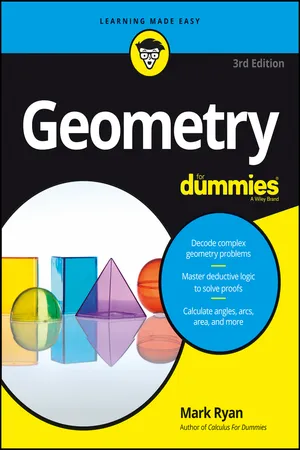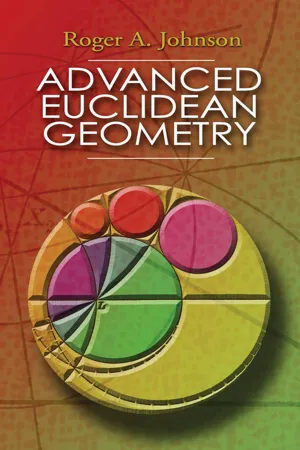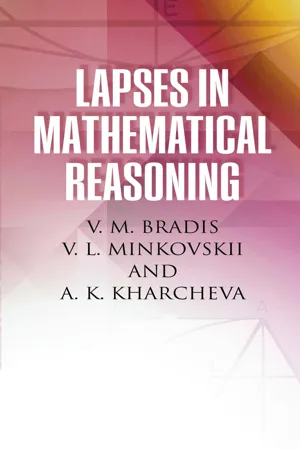Mathematics
Triangles
Triangles are three-sided polygons formed by connecting three non-collinear points. They are classified based on the length of their sides (equilateral, isosceles, or scalene) and the size of their angles (acute, right, obtuse). The sum of the interior angles of a triangle is always 180 degrees, and they are fundamental to various geometric and trigonometric principles.
Written by Perlego with AI-assistance
Related key terms
7 Key excerpts on "Triangles"
- eBook - ePub
- Mark Ryan(Author)
- 2016(Publication Date)
- For Dummies(Publisher)
Part 3Triangles: Polygons of the Three-Sided Variety
IN THIS PART … Get familiar with triangle basics. Have fun with right Triangles. Work on congruent triangle proofs.Passage contains an image Chapter 7
Grasping Triangle Fundamentals
IN THIS CHAPTER Looking at a triangle’s sides: Equal or unequal Uncovering the triangle inequality principle Classifying Triangles by their angles Calculating the area of a triangle Finding the four “centers” of a triangleConsidering that it’s the runt of the polygon family, the triangle sure does play a big role in geometry. Triangles are one of the most important components of geometry proofs (you see triangle proofs in Chapter 9 ). They also have a great number of interesting properties that you might not expect from the simplest possible polygon. Maybe Leonardo da Vinci (1452–1519) was on to something when he said, “Simplicity is the ultimate sophistication.”In this chapter, I take you through the triangle basics — their names, sides, angles, and area. I also show you how to find the four “centers” of a triangle.Taking In a Triangle’s Sides
Triangles are classified according to the length of their sides or the measure of their angles. These classifications come in threes, just like the sides and angles themselves. That is, a triangle has three sides, and three terms describe Triangles based on their sides; a triangle also has three angles, and three classifications of Triangles are based on their angles. I talk about classifications based on angles in the upcoming section “Getting to Know Triangles by Their Angles .”The following are triangle classifications based on sides:- Scalene triangle: A scalene triangle is a triangle with no congruent sides
- Isosceles triangle: An isosceles triangle is a triangle with at least two congruent sides
- Equilateral triangle: A equilateral triangle is a triangle with three congruent sides
Because an equilateral triangle is also isosceles, all Triangles are either scalene or isosceles. But when people call a triangle isosceles, they’re usually referring to a triangle with only two equal sides, because if the triangle had three equal sides, they’d call it equilateral. - eBook - ePub
- (Author)
- 2008(Publication Date)
- Trade Paper Press(Publisher)
similar . All circles are similar. All squares are similar. Triangles are similar if corresponding angles are equal.angles in Triangles The exterior angle of a triangle is equal to the sum of the opposite interior angles.triangle types of triangle.triangle A triangle is a three-sided plane figure, the sum of whose interior angles is 180°. Triangles can be classified by the relative lengths of their sides. A scalene triangle has three sides of unequal length; an isosceles triangle has at least two equal sides; an equilateral triangle has three equal sides (and three equal angles of 60°).median The median is the name given to a line from the vertex (corner) of a triangle to the midpoint of the opposite side.A right-angled triangle has one angle of 90°. If the length of one side of a triangle is l and the perpendicular distance from that side to the opposite corner is h (the height or altitude of the triangle), its area A = lh .hypotenuse The longest side of a right-angled triangle, opposite the right angle, is the hypotenuse. It is of particular application in the Pythagorean theorem (the square of the hypotenuse equals the sum of the squares of the other two sides), and in trigonometry where the ratios sine and cosine (see under trigonometry below) are defined as the ratios opposite/hypotenuse and adjacent/hypotenuse respectively.altitude The altitude of a figure is the perpendicular distance from a vertex (corner) to the base (the side opposite the vertex).circle Technical terms used in the geometry of the circle; the area of a circle can be seen to equal πr2 by dividing the circle into segments which form a rectangle.The Pythagorean theorem
The Pythagorean theorem states that in a right-angled triangle, the area of the square on the hypotenuse (the longest side) is equal to the sum of the areas of the squares drawn on the other two sides. If the hypotenuse is h units long and the lengths of the other sides are a and b , then h 2 = a 2 + b 2 - eBook - ePub
- Sandra Rush(Author)
- 2017(Publication Date)
- Research & Education Association(Publisher)
Trianglesare formed when three line segments form a closed figure. Triangles are one of the most important shapes in geometry. One of the properties of Triangles that you probably didn’t think about until now is that they are rigid. That means that once you have three sides attached in a triangle shape, you cannot change it. You cannot make one of the sides longer, and you cannot make any of the angles larger without changing all sides. This is why bridge supports have Triangles as their major structure.There are several kinds of Triangles, but they all have the following in common:HINT
Try this for yourself: Take two soda straws. Bend one into a four-sided figure and the other into a triangle. Hold together the angle where the ends of each straw meet. Now apply pressure on one of the other sides or angles. The four-sided figure collapses on itself, but the triangle stays rigid.1.They have three sides and three angles. In fact, that is what the word triangle means: three angles.2.The largest angle is across from the longest side and the smallest angle is across from the shortest side. 3.The measures of the three angles add up to 180°. So if you know the measures of two angles of a triangle, you can always find the third. This is a consequence of the rigidity of a triangle.4.Another fact that has to do with a triangle’s rigidity is that, if you know two sides and the angle between them, the other side and the other two angles are fixed. Finding the measures requires a knowledge of trigonometry, which is beyond what the GED® test covers. Can you see that once we have the lengths of sides DE and DF and we know ∠D, there is only one way to form a triangle (draw EF)?5.If you know one side and two angles in a triangle, the lengths of the other two sides are predetermined. Can you see above (right) that if we extend the two partial sides, they will meet at a point (let’s call it T) that depends on ∠R and ∠S - eBook - ePub
Making Sense of Mathematics for Teaching High School
Understanding How to Use Functions
- Edward C. Nolan, Juli K. Dixon, Farhsid Safi, Erhan Selcuk Haciomeroglu(Authors)
- 2016(Publication Date)
- Solution Tree Press(Publisher)
Figure 3.3 provides an illustration of how the unit circle is generated from right Triangles, each having a hypotenuse with a length of one unit. Notice how one of the vertices of the non-right angles in each triangle serves as the origin of a coordinate plane and is concurrent for all of the Triangles. The vertices of the other non-right angles form a circle of radius 1—the unit circle.Figure 3.2: ΔDEF is similar to ΔABC with a hypotenuse of length 1.Figure 3.3: Multiple right Triangles with hypotenuse equal to 1 form the unit circle.How does figure 3.3 connect to the Pythagorean theorem? The Pythagorean theorem states that in a right triangle, a2 + b2 = c2 , where a and b are the legs of the right angle and c is the hypotenuse. As previously demonstrated, the side lengths a and b of the right Triangles forming the unit circle can also be represented by trigonometric functions, so another way of writing the Pythagorean theorem is (sin A)2 + (cos A)2 = 1. This is an important trigonometric identity that will be explored in later mathematical study. How does this connect to the equation of a circle? As these are also values of x-coordinates and y-coordinates on the coordinate grid, you can extend this reasoning to show that x2 + y2 = 1, the equation of the unit circle.These extensions provide opportunities to make sense of trigonometric functions in ways that set the stage for studying algebraic representations of circles and applications of the unit circle.The ProgressionStudents have reasoned with shapes since kindergarten by examining attributes and creating increasingly precise definitions. They learned about angles, parallel lines, and right angles in grade 4 and the coordinate plane in grades 5 and 6. In the middle grades, students explored the relationship between surface area and volume of three-dimensional shapes; learned about all four transformations, congruence, and similarity; and proved and applied the Pythagorean theorem. Each of these areas is extended in high school. Following is a learning progression for how students extend this knowledge in studying geometry in high school. - eBook - ePub
- Roger A. Johnson(Author)
- 2013(Publication Date)
- Dover Publications(Publisher)
CHAPTER IV Triangles AND POLYGONS83. The present chapter is an assemblage of various theorems concerning Triangles, quadrilaterals, and other polygons, all of which can be established at once on the basis of the familiar elementary geometry and the results that have thus far been obtained. Considerable portions of this chapter, as well as most of Chapters V and VI, may be omitted without destroying the sequence. The reader who is desirous of proceeding at once to the general theory of the triangle, without delaying for material which, however interesting, is irrelevant to the main purpose, will read sections 84–992, 95–101, 104 a, and then pass on to Chapter V .84. We have first a theorem which is highly useful in the study of the triangle, because of the various forms which it assumes and the different corollaries which can be at once deduced from it.FIG . 18Theorem. If Pi is any point except A3 of the side A2 A3 of a triangle A1 A2 A3 , thenFor by the law of sines (15 b)Since also the theorem follows at once by combining these equations.Corollary. If A1 P1 and A1 Q1 are so drawn that angles A2 A1 P1 and Q1 A1 A3 are equal, then85. Theorem. If P1 , P2 , P3 are on the sides A2 A3 , A3 A1 , A1 A2 , respectively, of triangle A1 A2 A3 ,That is to say, the product of the ratios in which the sides of the triangle are divided equals the corresponding product for the sines of the angles subtended at the opposite vertices.86. Theorem. If P1 , Q2 are any points on A2 A3 , the “double ratio” composed of the ratio of the ratios in which they divide A2 A3 equals the corresponding double ratio for the sines of the angles subtended at A1 ;Theorem. If three lines, concurrent at O, are cut by a transversal at A, B, C, and by another at A′, B′, C′, then87. Theorem. - eBook - ePub
Military schools and courses of instruction in the science and art of war,
in France, Prussia, Austria, Russia, Sweden, Switzerland, Sardinia, England, and the United States. Drawn from recent official reports and documents. Revised Edition
- (Author)
- 2013(Publication Date)
- Perlego(Publisher)
1. OF PLANE FIGURES. Measure of the distance of two points.—Two finite right lines being given, to find their common measure, or at least their approximate ratio.Of angles.—Right, acute, obtuse angles.—Angles vertically opposite are equal.Of Triangles.—Angles and sides.—The simplest cases of equality.—Elementary problems on the construction of angles and of Triangles.Of perpendiculars and of oblique lines.Among all the lines that can be drawn from a given point to a given right line, the perpendicular is the shortest, and the oblique lines are longer in proportion to their divergence from the foot of the perpendicular.Properties of the isosceles triangle.—Problems on tracing perpendiculars.—Division of a given straight line into equal parts.Cases of equality of right-angled Triangles.Of parallel lines.Properties of the angles formed by two parallels and a secant.—Reciprocally, when these properties exist for two right lines and a common secant, the two lines are parallel.1 —Through a given point, to draw a right line parallel to a given right line, or cutting it at a given angle.—Equality of angles having their sides parallel and their openings placed in the same direction.Sum of the angles of a triangle.The parts of parallels intercepted between parallels are equal, and reciprocally. Three parallels always divide any two right lines into proportional parts. The ratio of these parts may be incommensurable.—Application to the case in which a right line is drawn, in a triangle, parallel to one of its sides. - eBook - ePub
- V. M. Bradis, L. Minkovskii, A. K. Kharcheva(Authors)
- 2016(Publication Date)
- Dover Publications(Publisher)
3 , and represent the second, third, and fourth terms of that same geometric progression.The side a may be arbitrary. But the number q is not completely arbitrary. It has to satisfy the inequality aq2 < a + aq, since the greatest side of the triangle must be less than the sum of the two other sides. Dividing both members of that inequality by a, we obtain the inequality q2 – q – 1 < 0, which has to be satisfied by the number q (consideration of the second triangle leads to the same inequality). By factoring the second degree trinomial q2 – q – 1, we rewrite this inequality in the formor in the form , and we note that the expression in the second bracket is always positive for q > 1. Consequently, the expression in the first bracket must be negative, and therefore:Thus, two similar unequal Triangles have two pairs of respectively equal sides if, and only if, the sides of the first triangle are equal to a, aq, aq2 , and the sides of the second are equal to aq, aq2 , aq3 , where the side a is arbitrary and the number q is taken between 1 and .We can find any number of pairs of such Triangles.64. Trisection of an angleTo carry out the trisection of an angle means to divide an angle into three equal parts. To do this is, of course, not at all difficult. We may, for example, measure the given angle with a protractor, divide the measured number of degrees by three, and then, by means of the same protractor, lay off an angle containing the quotient in degrees. We can, however, manage also without the protractor, applying the method of “successive approximation” —having constructed an arc of arbitrary radius, for which the given angle is the central angle, we lay off by eye a chord corresponding to a third part of the arc, and lay off that chord successively three times along the arc, beginning from one of its ends. If we then find ourselves on the other end of the arc, the problem is solved. If, however, as usually happens, we do not reach the other end of the arc, or pass beyond it, then the chord taken by eye has to be corrected, increasing or decreasing it by one-third of the distance from the point obtained to the end of the arc, where this one-third we take again by eye. This corrected chord is again laid off on the arc, and in case of necessity we correct it again in the same manner. Each new (corrected) chord will give an ever more exact solution and, finally, after repeating the operation a few times, we obtain a chord which will be laid off the given arc almost exactly three times, and the trisection of the angle will have been carried out. Obviously, these two methods allow us to divide the given angle not only into three but into any number of equal parts.
Learn about this page
Index pages curate the most relevant extracts from our library of academic textbooks. They’ve been created using an in-house natural language model (NLM), each adding context and meaning to key research topics.






